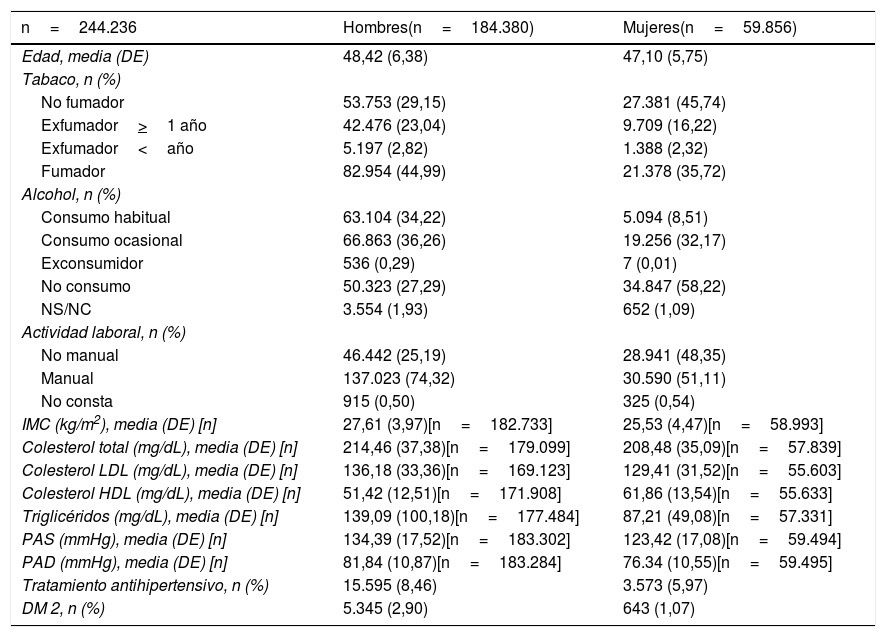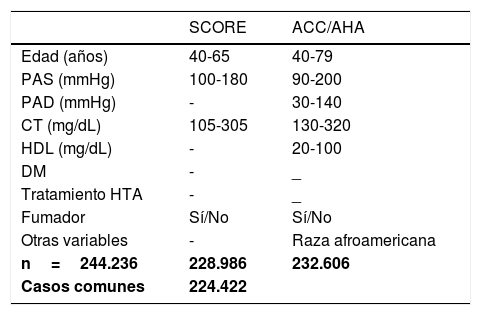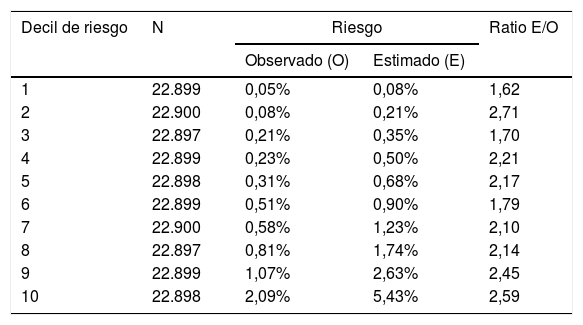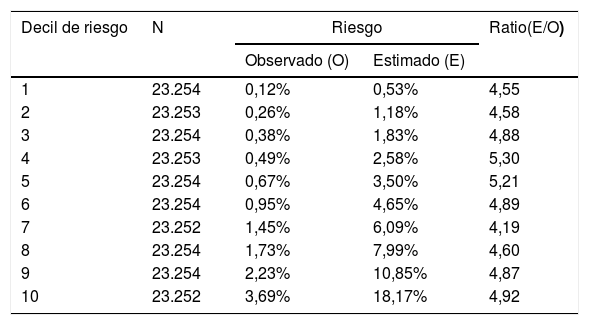Validar externamente los modelos europeo y norteamericano de cálculo de riesgo cardiovascular en prevención primaria.
MétodosEstudio transversal de una cohorte nacional de población laboralmente activa. Se incluyeron trabajadores sin antecedentes de enfermedad cardiovascular que acudieron a una revisión laboral entre los años 2004 y 2007, y se siguieron hasta 2017.
ResultadosParticiparon 244.236 sujetos. El 24,5% eran mujeres, la edad media se situó en 48,10 años (DE 6,26). El riesgo medio según el modelo europeo SCORE fue de 1,70 (DE 1,81) para hombres y de 0,37 (DE 0,53) para mujeres. Según el modelo norteamericano PCE, el riesgo medio fue de 6,98 (DE 5,66) para hombres y de 1,97 (DE 1,96) para mujeres. Se registró un total de 1.177 eventos (0,51%) considerados en la calculadora SCORE, y un total de 2.330 eventos (1%) considerados según las PCE. El estadístico C de Harrell fue de 0,746 (SCORE) y 0,725 (PCE). La sensibilidad y especificidad para el punto de corte del 5% en SCORE fue del 17,59% (IC95% 15,52-19,87%) y 95,68% (IC95% 95,59-95,76%) y para el punto de corte del 20% de las PCE de 9,06% (IC95% 7,96-10,29%) y 97,55% (IC95% 97,48-97,61%), respectivamente.
ConclusionesLas tablas europeas del SCORE y americanas de las PCE sobreestiman el riesgo en nuestra población, manteniendo una discriminación aceptable. SCORE mostró mejores índices de validez que las PCE. El perfil de riesgo de las poblaciones va cambiando, por lo que es necesario ir actualizando las ecuaciones que incluyan información de poblaciones más contemporáneas.
This work aims to externally validate the European and American models for calculating cardiovascular risk in the primary prevention.
MethodsThis is a cross-sectional study of a nation-wide cohort of individuals who are active in the work force. Workers without a medical history cardiovascular disease who attended occupational health check-ups between 2004 and 2007 were included. They were followed-up on until 2017.
ResultsA total of 244,236 subjects participated. Of them, 24.5% were women and the mean age was 48.10 years (SD 6.26). According to the European SCORE risk chart, the mean risk was 1.70 (SD 1.81) for men and 0.37 (SD 0.53) for women. According to the North American PCE model, the mean risk was 6.98 (SD 5.66) for men and 1.97 (SD 1.96) for women. A total of 1,177 events (0.51%) were registered according to the SCORE tool and 2,330 events (1.00%) were registered according to the PCE tool. The Harrell's C-statistic was 0.746 for SCORE and 0.725 for PCE. Sensitivity and specificity for the SCORE'S 5% cut-off point were 17.59% (95%CI 15.52%-19.87%) and 95.68% (95%CI 95.59%-95.76%). Sensitivity and specificity for the PCE's 20% cut-off point were 9.06% (95%CI 7.96%-10.29%) and 97.55% (95%CI 97.48%-97.61%), respectively.
ConclusionsThe European SCORE and North American PCE models overestimate the risk in our population but with an acceptable discrimination. SCORE showed better validity indices than the PCE. The population's risk is continuously changing; therefore, it is important continue updating the equations to include information on current populations.
Article
Diríjase desde aquí a la web de la >>>FESEMI<<< e inicie sesión mediante el formulario que se encuentra en la barra superior, pulsando sobre el candado.

Una vez autentificado, en la misma web de FESEMI, en el menú superior, elija la opción deseada.

>>>FESEMI<<<










